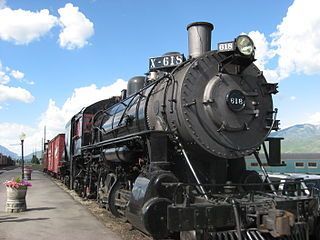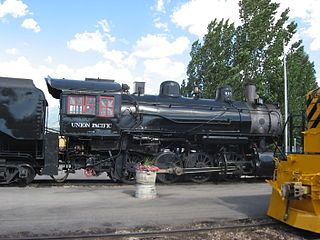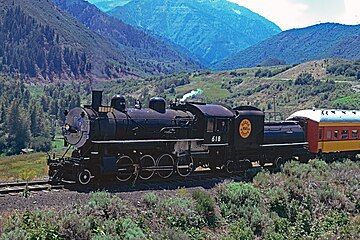Union Pacific 618
This article needs additional citations for verification. (October 2021) |
| Union Pacific 618 | |||||||||||||||||||
|---|---|---|---|---|---|---|---|---|---|---|---|---|---|---|---|---|---|---|---|
 Former Union Pacific 618 running on the Heber Valley Railroad | |||||||||||||||||||
| |||||||||||||||||||
| |||||||||||||||||||
| |||||||||||||||||||
| |||||||||||||||||||
| References:[1][2] | |||||||||||||||||||
Union Pacific 618 is a class "C-2" 2-8-0 "Consolidation" type steam locomotive previously owned by the Union Pacific Railroad. The engine is now located in Heber City, Utah and owned by the Heber Valley Railroad. Built in July 1907 by the Baldwin Locomotive Works (BLW) of Eddystone, Pennsylvania, No. 618 is one of 2 surviving Oregon Short Line C-2 locomotives. The locomotive operated in revenue service until 1958. It was then donated to the State of Utah, where it sat on display for many years. In the mid 1960s, a full restoration effort began on the locomotive with the promise of heading up Utah's first tourist railroad in Heber City after the state donated the engine to the National Railway Historical Society. Today, it is one of UP's oldest locomotives and the first steam locomotive to be removed from a Public Park, and put back into operational condition in excursion service.[1] The engine currently is out of service in Heber City, Utah undergoing restoration back to operating condition.[1]
History
[edit]Revenue service
[edit]In July 1907, the Oregon Short Line Railroad received No. 1068. The 2-8-0 locomotive was part of the C-2 Class of locomotives for the OSL, which was a subsidiary of the Union Pacific.[1] The 2-8-0 was part of a three locomotive order from the Oregon Short Line Railroad built that month by Baldwin and numbered 1066-1068.[1]
During World War II, the locomotive pulled trains from the Ogden Yards to the Ogden Army Defense Base. This lasted from 1941-1945 when the Japanese surrendered. Afterward, the engine continued to handle freight in Utah and Idaho. Around 1949-1951, the standard square coal tender was replaced with a Vanderbilt styled tender. The reason why is still unknown. Through the 1950s, the locomotive continued to operate on freight duties until the engine was replaced by diesel locomotives on the Union Pacific. The locomotive's last assignment was to act as a snowplow near the Geneva Steel Mill.[3] The Union Pacific had decided to donate 618 to the State of Utah with the agreement that the locomotive could not be sold, scrapped, or given to an out of state railroad.[1] In late May of 1958, the locomotive was fired up what some thought was the very last time. It pulled into the Diesel Complex in Salt Lake City. It was then pushed across North Temple Street to the County Fairgrounds and placed on display.[1]
Retirement
[edit]Initially, the locomotive was fairly well received by the public. However, after a while, the locomotive had started to become an eyesore.[1] Many people wanted to get rid of No. 618, but the stipulations of the Union Pacific giving No. 618 to the state was that it couldn't be scrapped, sold, or given out of state. This prompted many to speculate what else to do with the locomotive. In the mid 1960s, there was a thought of just burying the engine. According to Stephen Carr, a historian at the Heber Valley Railroad, he stated that, "There was a thought of digging a big hole right next, next to it and tumbling it into the hole. Because nobody knew what else to do with it and nobody was interested in it."[1] In addition, the fairgrounds also were going to be expanded, and the locomotive needed to be moved to allow it. However, members of the National Railway Historical Society decided to step in and in 1969, they convinced the state to donate the engine to the Promontory Chapter of the National Railway Historical Society.[1] After the donation, the group started conversations with the state to use the locomotive in a brand new tourist railroad based out of Heber City, Utah on the Wasatch Railway Museum.
Two years earlier in 1967, the Denver & Rio Grande Western had abandoned the Provo Branch Line that linked Provo to Heber City. The tracks were planned to be ripped up and be turned over as an extension of U.S Route 189.[2] Several locals and businessmen fought to keep the tracks in order to start a potential tourist operation. When the Wasatch Mountain Railway moved their equipment onto the branch, Utah told them to leave. UDOT gave the historical group until April 1, 1972 to move its equipment.[2]
Excursion service
[edit]On December 5, 1970, restoration work was completed and No. 618 moved under its own power again for the first time in twelve years.[2] The railroad more or less balked at the order and operated the No. 618 to its new home in Heber City from Provo on December 7, 1970, with four U.S. Army hospital cars and a diver caboose. The engine would eventually arrive in Heber City Utah later that night.[2]
By 1971, the railroad added to their fleet with Pacific Lumber Co. No. 35 and a 3-Truck Shay No. 4 from the Yosemite Lumber Company.[2] On January 3, 1971, No. 618 was fired up and ran the first excursion on the Heber Creeper. In November, the state decided to rescind their eviction and granted the Wasatch Railway Museum a 25 year lease on the former branch.[2] It ran excursion trains from 1970 until 1976 when it was taken out of service for repairs.[1] After sitting for ten years, the railroad moved the engine in the shops were they began rebuilding the engine.[1]
It eventually return to service in 1986 and would continue to ran excursions trains until October 1990 when the Heber Creeper went out of business, its fired was dropped for the last and was once again retired from service and put into storage.[1] In 1992, State of Utah moved all of its railroad equipment for use by the Heber Valley Railroad.[1] For two years, the engine sat on display until 1993 when it was moved into the shops for restoration back to operating condition.[1] The restoration was completed on May 8, 1995 and it pulled its first train of the 1995 season to Deer Creek Dam and back on May 13, 1995.[1]
In 2007, the locomotive celebrated its 100th birthday and was relettered and renumbered as Oregon Short Line No. 1068.[1]
Disposition
[edit]In 2010, No. 618 hauled its last trains during Memorial Day weekends for photo charters before its boiler ticket expired. After the event, it was indefinitely taken out of service in June 2010 and put on static display in front of the railroad dept were it was previously awaiting its 1,472-day inspection.[4] In October 2014, it was removed from its display track and moved into the shops for inspection and restoration work on the engine officially began.[4] The engine will also be converted to burn oil when finished.[4] As of May 2022, restoration work is still in progress.[4]
Gallery
[edit]-
No. 618 on static display in August 2010.
-
No. 618 on static display near the dept in August 2010.
-
No. 618 running on the original Heber Creeper
See also
[edit]- Union Pacific 4466
- Union Pacific 1243
- Oregon Railroad and Navigation 197
- Southern Pacific 1744
- Great Western 60
References
[edit]- ^ a b c d e f g h i j k l m n o p q "No. 618 – Heber Valley Railroad". Retrieved 2021-10-25.
- ^ a b c d e f g Strack, Don. "Heber Valley Railroad". utahrails.net. Retrieved 2021-10-26.
- ^ "No. 300 – Heber Valley Railroad". Retrieved 2021-10-26.
- ^ a b c d "The No. 618 Restoration Blog". Retrieved 2021-10-25.



